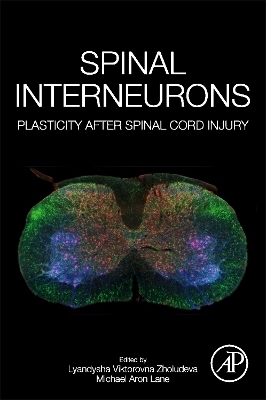
Spinal Interneurons
Academic Press Inc (Verlag)
978-0-12-819260-3 (ISBN)
Spinal Interneurons provides a focused overview of how scientists classify interneurons in general, the techniques used to identify subsets of interneurons, their roles in specific neural circuits, and the scientific evidence for their neuroplasticity. Understanding the capacity for neuroplasticity and identity of specific spinal interneurons that are optimal for recovery, may help determine cellular candidates for developing therapies.
Spinal Interneurons provides neuroscientists, clinicians, and trainees a reference book exclusively concentrating on spinal interneurons, the techniques and experiments employed to identify and study these cells as part of normal and compromised neural circuits, and highlights the therapeutic potential of these cells by presenting the relevant pre-clinical and clinical work to date. People in industry will also benefit from this book, which compiles the latest in therapeutic strategies for targeting spinal interneurons, what considerations there are for the development and use of treatments, and how such treatments can not only be translated to the clinic, but how existing treatments should be appropriately reverse-translated to the bench.
Dr. Lyandysha (Lana) Zholudeva is currently a Scientist at the Gladstone Institutes. Having a broad research experience beginning as an undergraduate in non-invasive imaging techniques for quantifying cellular metabolism (Creighton University), to completing her doctoral work in spinal cord injury, plasticity and repair (Drexel University College of Medicine), has contributed to a drive for translational science. Her current work is focused on engineering human spinal interneurons for spinal cord repair and disease modeling. Her ongoing research, which is supported by government funding, private foundations and philanthropic investments, has led to several patents for her discoveries. Dr. Michael Aron Lane is an Associate Professor in the Department of Neurobiology and Anatomy at the Drexel University College of Medicine. He is a Primary Investigator in the Marion Murray Spinal Cord Research Center, where his research team is investigating the neuroplastic potential after spinal cord injury, and developing strategies to promote repair and recovery (e.g., activity-based therapies, neuromodulation and cellular transplantation). He is committed to maintaining a translational focus to his pre-clinical research and retains close ties with scientists, engineers, clinical professionals and people living with spinal cord injury. He is also deeply invested in the training of future scientists having served in multiple external workshops and courses on spinal cord injury, serving as co-director of a Neuroscience Summer Camp for High School students, and Co-Director of a graduate training program for spinal cord injury research funded by the National Institutes of Health.
Section 1: Spinal Interneurons – Motor and Sensory Neuronal Networks 1. The Neuronal Cell Types of the Spinal Cord 2. Identified Interneurons Contributing to Locomotion in Mammals 3. Decoding Touch: Peripheral and Spinal Processing 4. Spinal Interneurons and Pain: functional organization of dorsal horn neurons in acute and persistent pain 5. Cholinergic Spinal Interneurons 6. Spinal Interneurons, Motor Synergies and Modularity
Section 2: Spinal Interneurons – Gatekeepers to plasticity following injury 7. Spinal Interneurons Contribute to Adaptive and Maladaptive Plasticity after Spinal Cord Injury 8. Changes in motor outputs after spinal cord injury 9. Respiratory Spinal Interneurons 10. Spinal Interneuronal Control of the Lower Urinary Tract 11. Spinal interneurons and Autonomic Dysreflexia after Injury 12. Human Spinal Networks: Motor Control, Autonomic Regulation and Somatic-Visceral Neuromodulation 13. Spinal Interneurons post-Injury: Emergence of a different perspective on spinal cord injury 14. The Unified Theory of Central Pattern Generator Function After Spinal Cord Injury 15. Spinal Interneurons & Cell transplantation 16. Spinal Interneurons and Cellular Engineering
| Erscheinungsdatum | 12.12.2022 |
|---|---|
| Verlagsort | San Diego |
| Sprache | englisch |
| Maße | 152 x 229 mm |
| Gewicht | 770 g |
| Themenwelt | Medizin / Pharmazie ► Medizinische Fachgebiete ► Neurologie |
| Naturwissenschaften ► Biologie ► Humanbiologie | |
| Naturwissenschaften ► Biologie ► Zoologie | |
| ISBN-10 | 0-12-819260-7 / 0128192607 |
| ISBN-13 | 978-0-12-819260-3 / 9780128192603 |
| Zustand | Neuware |
| Informationen gemäß Produktsicherheitsverordnung (GPSR) | |
| Haben Sie eine Frage zum Produkt? |
aus dem Bereich


